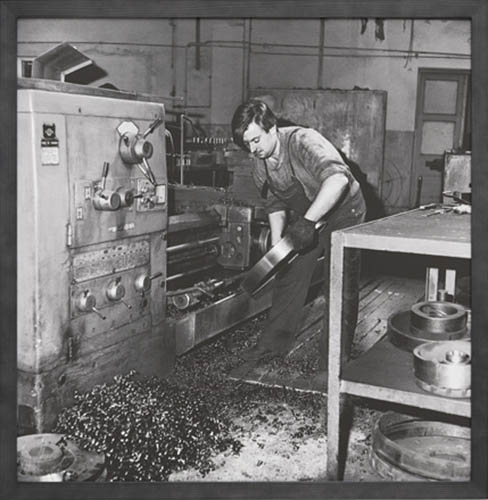This post is also available in:
 French
French
Before the invention of photography revolutionised our way of looking at the world, portraiture was largely confined to depicting the wealthiest and most powerful people in the world. The men and women who dominated England during the Tudor period became especially addicted to showing themselves off in grandiose full-length paintings, where foppish attire often seems more important than their preening facial features. Later artists as defiant as Goya struggled against becoming dutiful, orthodox and formulaic portraitists. But judging by his current exhibition at the National Gallery, even the rebellious Goya was caught half-way between satirising Spanish royalty and celebrating its existence in his own work. Paintings of regal and aristocratic patrons could hardly be further removed from Craigie Horsfield’s images of Polish workers. No satire can be detected here, and the factories where they earn their living have nothing to do with ostentatious splendour. Horsfield’s decision to photograph them in black and white reinforces his refusal to prettify these grim locations in any way at all. They are forbidding places, inhabited by people who seem caught up in jobs demanding tough physical labour, long hours and very little remuneration. One of the workers, a moustachioed man, has laid down his hammer in order to straighten himself up and look away. But only for a moment: as soon as Horsfield has finished photographing him, this unsmiling man will doubtless resume his task once more.The other workers are also involved in their jobs, mostly requiring intense concentration as they manipulate machinery with practised skill. One woman, photographed in Krakow during the 1980s, focuses on clasping and controlling an all-important lever. She looks tired, yet not as much as the bald-headed man in another image who sits and stares at his machine. Maybe he is simply pausing for an instant, but his expression suggests that he feels disconsolate as well.As our eyes move from one image to the next, we realise that Horsfield’s empathy reveals just how isolated each of these individuals really is. The longer we gaze at them, the more stranded they become. At the same time, though, they refuse to feel defeated. Ultimately, Horsfield’s subtle ability to convey this sensitive insight means that we enter into their lives, and admire the resolve they maintain in order to cope with the demands of their daily predicament.
photographs by CRAIGIE HORSFIELD
From 27/11/2015 to 26/02/2016
LARGE GLASS
392 Caledonian Road
N1 1DN LONDRE
Royaume Uni
Opening hours : Wednesday to Saturday 11.00am–6.00pm
Phone : +44 (0)20 7609 9345
www.largeglass.co.uk
From 27/11/2015 to 26/02/2016
LARGE GLASS
392 Caledonian Road
N1 1DN LONDRE
Royaume Uni
Opening hours : Wednesday to Saturday 11.00am–6.00pm
Phone : +44 (0)20 7609 9345
www.largeglass.co.uk



